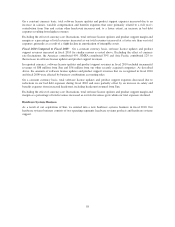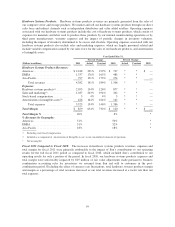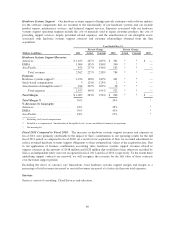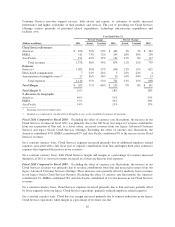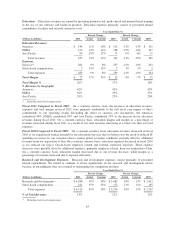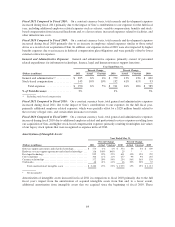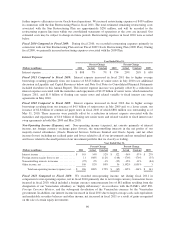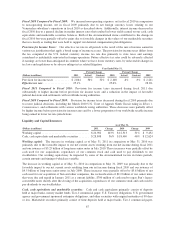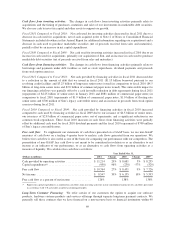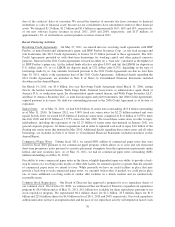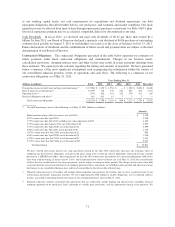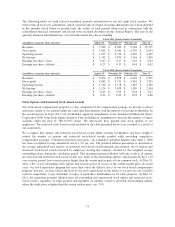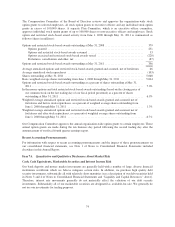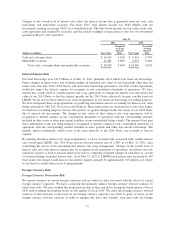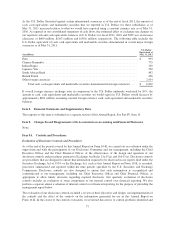Oracle 2011 Annual Report Download - page 70
Download and view the complete annual report
Please find page 70 of the 2011 Oracle annual report below. You can navigate through the pages in the report by either clicking on the pages listed below, or by using the keyword search tool below to find specific information within the annual report.
corporate notes, U.S. Treasury obligations, U.S. government agency and government sponsored enterprise
obligations and certain other securities. The increase in cash, cash equivalents and marketable securities at
May 31, 2011 in comparison to May 31, 2010 was primarily due to cash generated from our operating activities,
our issuance of $3.25 billion of senior notes in July 2010 and $1.15 billion of short-term borrowings made
pursuant to certain of our revolving credit agreements. Cash, cash equivalents and marketable securities included
$20.4 billion held by our foreign subsidiaries as of May 31, 2011, $16.1 billion of which we consider indefinitely
reinvested earnings outside the United States. These undistributed earnings would be subject to U.S. income tax
if repatriated to the United States. Assuming a full utilization of the foreign tax credits, the potential deferred tax
liability associated with these undistributed earnings would be approximately $4.6 billion. The amount of cash,
cash equivalents and marketable securities that we report in U.S. Dollars for a significant portion of the cash held
by these subsidiaries is subject to translation adjustments caused by changes in foreign currency exchange rates
as of the end of each respective reporting period (the offset to which is recorded to accumulated other
comprehensive income in our consolidated balance sheet). As the U.S. Dollar generally weakened against certain
major international currencies during fiscal 2011, the amount of cash, cash equivalents and marketable securities
that we reported in U.S. Dollars for these subsidiaries increased as of May 31, 2011 relative to what we would
have reported using constant currency rates as of May 31, 2010. The aforementioned increases in our cash, cash
equivalents and marketable securities balances were partially offset by the repayment of $2.25 billion of our
senior notes which matured in January 2011, the repayment of $881 million of commercial paper notes, the usage
of $1.9 billion of net cash for acquisitions, repurchases of our common stock, and the payments of cash dividends
to our stockholders.
The increase in cash, cash equivalents and marketable securities at May 31, 2010 in comparison to May 31, 2009
was primarily due to cash generated from our operating activities and our issuance of $4.5 billion of senior notes
in July 2009. The increase was partially offset by a decrease in our reported cash, cash equivalents and
marketable securities balances caused by the strengthening of the U.S. Dollar in comparison to certain major
international currencies during fiscal 2010. Additionally, the increase in our cash, cash equivalents and
marketable securities balances was partially offset by $5.6 billion of net cash used for our acquisition of Sun and
other companies, the repayment of $700 million of Sun’s legacy convertible notes, repurchases of our common
stock, and the payment of cash dividends to our stockholders.
Days sales outstanding, which is calculated by dividing period end accounts receivable by average daily sales for
the most recently completed fiscal quarter, modestly increased to 55 days at May 31, 2011 in comparison to 53
days at May 31, 2010. The days sales outstanding calculation excludes the adjustment that reduces our acquired
software license updates and product support obligations and hardware systems support obligations to fair value.
Year Ended May 31,
(Dollars in millions) 2011 Change 2010 Change 2009
Cash provided by operating activities .............. $ 11,214 29% $ 8,681 5% $ 8,255
Cash used for investing activities .................. $ (6,081) -41% $ (10,319) 297% $ (2,599)
Cash provided by (used for) financing activities ...... $ 516 -81% $ 2,664 -160% $ (4,422)
Cash flows from operating activities: Our largest source of operating cash flows is cash collections from our
customers following the purchase and renewal of their software license updates and product support agreements.
Payments from customers for these support agreements are generally received near the beginning of the
contracts’ terms, which are generally one year in length. We also generate significant cash from new software
license sales, sales of hardware systems products and hardware systems support arrangements and, to a lesser
extent, services. Our primary uses of cash from operating activities are for personnel related expenditures,
material and manufacturing costs related to the production of our hardware systems products, taxes and leased
facilities.
Net cash provided by operating activities increased in fiscal 2011 and 2010 primarily due to higher net income
adjusted for amortization of intangible assets, stock-based compensation and depreciation in each of these
periods. These increases in fiscal 2011 and 2010 were partially offset by certain unfavorable changes in working
capital, primarily increases in net trade receivables resulting from increases in revenues during our fiscal fourth
quarters of fiscal 2011 and 2010, respectively, in comparison to the prior fiscal years.
68


